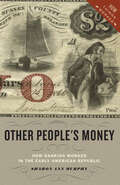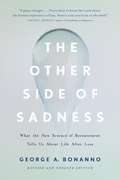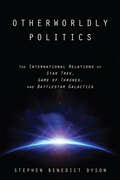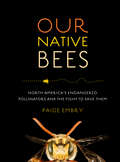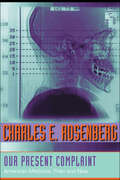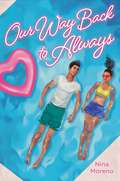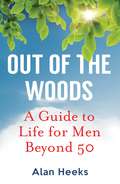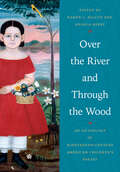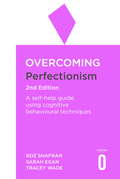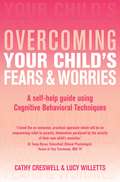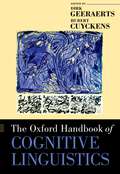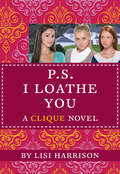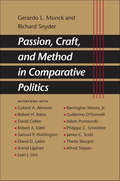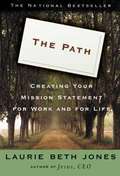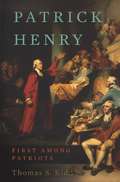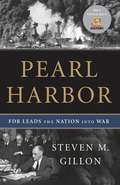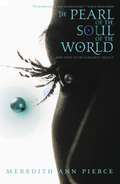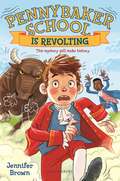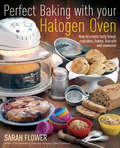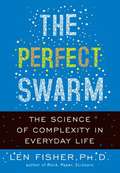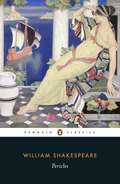- Table View
- List View
Other People's Money: How Banking Worked in the Early American Republic (How Things Worked)
by Sharon Ann MurphyPieces of paper that claimed to be good for two dollars upon redemption at a distant bank. Foreign coins that fluctuated in value from town to town. Stock certificates issued by turnpike or canal companies;¢;‚¬;€?worth something... or perhaps nothing. IOUs from farmers or tradesmen, passed around by people who could not know the person who first issued them. Money and banking in antebellum America offered a glaring example of free-market capitalism run amok;¢;‚¬;€?unregulated, exuberant, and heading pell-mell toward the next "panic" of burst bubbles and hard times. In Other People;€™s Money, Sharon Ann Murphy explains how banking and money worked before the federal government, spurred by the chaos of the Civil War, created the national system of US paper currency. Murphy traces the evolution of banking in America from the founding of the nation, when politicians debated the constitutionality of chartering a national bank, to Andrew Jackson;€™s role in the Bank War of the early 1830s, to the problems of financing a large-scale war. She reveals how, ultimately, the monetary and banking structures that emerged from the Civil War also provided the basis for our modern financial system, from its formation under the Federal Reserve in 1913 to the present. Touching on the significant role that numerous historical figures played in shaping American banking;¢;‚¬;€?including Alexander Hamilton, James Madison, Benjamin Franklin, Henry Clay, Daniel Webster, and Louis Brandeis;¢;‚¬;€?Other People;€™s Money is an engaging guide to the heated political fights that surrounded banking in early America as well as to the economic causes and consequences of the financial system that emerged from the turmoil. By helping readers understand the financial history of this period and the way banking shaped the society in which ordinary Americans lived and worked, this book broadens and deepens our knowledge of the Early American Republic.
Other People's Money: How Banking Worked in the Early American Republic (How Things Worked)
by Sharon Ann MurphyPieces of paper that claimed to be good for two dollars upon redemption at a distant bank. Foreign coins that fluctuated in value from town to town. Stock certificates issued by turnpike or canal companies;¢;‚¬;€?worth something... or perhaps nothing. IOUs from farmers or tradesmen, passed around by people who could not know the person who first issued them. Money and banking in antebellum America offered a glaring example of free-market capitalism run amok;¢;‚¬;€?unregulated, exuberant, and heading pell-mell toward the next "panic" of burst bubbles and hard times. In Other People;€™s Money, Sharon Ann Murphy explains how banking and money worked before the federal government, spurred by the chaos of the Civil War, created the national system of US paper currency. Murphy traces the evolution of banking in America from the founding of the nation, when politicians debated the constitutionality of chartering a national bank, to Andrew Jackson;€™s role in the Bank War of the early 1830s, to the problems of financing a large-scale war. She reveals how, ultimately, the monetary and banking structures that emerged from the Civil War also provided the basis for our modern financial system, from its formation under the Federal Reserve in 1913 to the present. Touching on the significant role that numerous historical figures played in shaping American banking;¢;‚¬;€?including Alexander Hamilton, James Madison, Benjamin Franklin, Henry Clay, Daniel Webster, and Louis Brandeis;¢;‚¬;€?Other People;€™s Money is an engaging guide to the heated political fights that surrounded banking in early America as well as to the economic causes and consequences of the financial system that emerged from the turmoil. By helping readers understand the financial history of this period and the way banking shaped the society in which ordinary Americans lived and worked, this book broadens and deepens our knowledge of the Early American Republic.
The Other Side of Sadness: What the New Science of Bereavement Tells Us About Life After Loss
by George A. BonannoIn this thoroughly revised and updated classic, a renowned psychologist shows that mourning is far from predictable, and all of us share a surprising ability to be resilientThe conventional view of grieving--encapsulated by the famous five stages of grief: denial, anger, bargaining, depression, and acceptance--is defined by a mourning process that we can only hope to accept and endure. In The Other Side of Sadness, psychologist and emotions expert George Bonanno argues otherwise. Our inborn emotions--anger and denial, but also relief and joy--help us deal effectively with loss. To expect or require only grief-stricken behavior from the bereaved does them harm. In fact, grieving goes beyond mere sadness, and it can actually deepen interpersonal connections and even lead to a new sense of meaning in life.
Otherworldly Politics: The International Relations of <I>Star Trek</I>, <I>Game of Thrones</I>, and <I>Battlestar Galactica</I>
by Stephen Benedict DysonIn Otherworldly Politics, Stephen Benedict Dyson examines the fictional but deeply political realities of three television shows: Star Trek, Game of Thrones, and Battlestar Galactica.Dyson explains how these shows offer alternative histories and future possibilities for humanity. Fascinated by politics and history, science fiction and fantasy screenwriters and showrunners suffuse their scripts with real-world ideas of empire, war, civilization, and culture, lending episodes a compelling intricacy and contemporary resonance.Dyson argues that science fiction and fantasy television creators share a fundamental kinship with great minds in international relations. Screenwriters like Gene Roddenberry, George R. R. Martin, and Ronald D. Moore are world-builders of no lesser creativity, Dyson argues, than theorists such as Woodrow Wilson, Kenneth Waltz, and Alexander Wendt. Each of these thinkers imagines a realm, specifies the rules of its operation, and by so doing shows us something about ourselves and how we interact with one another. Combining intellectual and real-world history with lucid theoretical analysis, the book is a vital challenge to scholars and a spur to creative thinking for fans of these three influential shows.
Our Native Bees: North America's Endangered Pollinators and the Fight to Save Them
by Paige EmbryOur Native Bees is the result of Paige Embry&’s yearlong quest to learn more about the forgotten, yet fundamental, native bees of North America.
Our Present Complaint: American Medicine, Then and Now
by Charles E. RosenbergCharles E. Rosenberg, one of the world's most influential historians of medicine, presents a fascinating analysis of the current tensions in American medicine. Situating these tensions within their historical and social contexts, Rosenberg investigates the fundamental characteristics of medicine: how we think about disease, how the medical profession thinks about itself and its moral and intellectual responsibilities, and what prospective patients—all of us—expect from medicine and the medical profession. He explores the nature and definition of disease and how ideas of disease causation reflect social values and cultural negotiations. His analyses of alternative medicine and bioethics consider the historically specific ways in which we define and seek to control what is appropriately medical. At a time when clinical care and biomedical research generate as much angst as they offer cures, this volume provides valuable insight into how the practice of medicine has evolved, where it is going, and how lessons from history can improve its prognosis.
Our Way Back to Always
by Nina MorenoTo All the Boys I've Loved Before meets Since You&’ve Been Gone in this effervescent romance about childhood best friends reconnecting, full of sunny days, warm nights, first kisses, and mended hearts. Lou Patterson and Sam Alvarez were inseparable—the best of friends—until the most embarrassing middle school promposal ever. Now, four years later, Lou is an introverted romantic who&’s bearing the weight of her mother&’s expectations. Meanwhile, Sam is the golden boy with plenty of friends who&’s still mourning the death of his father. When Lou finds the bucket list she and Sam wrote together as kids, she&’s disappointed to see that she hasn&’t accomplished a single one of her goals. Go to a party? Nope. Pull the greatest prank of all time? Still no. Learn how to be a really good kisser? Definitely not. Lou sets out to finish the list, and in a stroke of fate, Sam decides to tag along, stirring up old arguments and some very new feelings. But with the bucket list to guide them, Sam and Lou might just be able to find a way toward the future and each other.
Out Of The Woods: A Guide to Life for Men Beyond 50
by Alan HeeksThis book is a guide for the maturing man: complete with route-finder, service areas, scenic highlights and emergency callout advice. It gathers the best wisdom and experience of many men on enjoying your best years to the full, on the skills you need to handle the losses and shipwrecks, and on how to grow through them. It offers insights, inspiration, practical advice and resources for further help.The aim is simple: enjoy life now!The book offers wisdom from the unexpected, like a Wiltshire wood, football, Sufi mystics, car maintenance, and heroic myth.Topics in the book include:Change and renewal.A fresh look at relationships.Work, money - and fulfilment.Tackling health issues.Family Dynamics: ageing parents and lots more.Last Chance Saloon: addictions, anger, depression, alternatives.Dreams, dawns, dying, inspiration.Giving and receiving: friends, groups, communities.Sex: Yes you can!Maturing organically: sustaining your happiness, giving back.The book offers an easy, entertaining read to guide men through this new stage of life.It's also helpful for partners, family and friends who want to understand and support them.To handle new needs and challenges there are self test exercises, and further resource guides.
Over the River and Through the Wood: An Anthology of Nineteenth-Century American Children's Poetry
by Karen L. Kilcup Angela SorbyOver the River and Through the Wood is the first and only collection of its kind, offering readers an unequaled view of the quality and diversity of nineteenth-century American children's poetry. Most American poets wrote for children—from famous names such as Ralph Waldo Emerson to less familiar figures like Christina Moody, an African American author who published her first book at sixteen. In its excellence, relevance, and abundance, much of this work rivals or surpasses poetry written for adults, yet it has languished—inaccessible and unread—in old periodicals, gift books, and primers. This groundbreaking anthology remedies that loss, presenting material that is both critical to the tradition of American poetry and also a delight to read.Complemented by period illustrations, this definitive collection includes work by poets from all geographical regions, as well as rarely seen poems by immigrant and ethnic writers and by children themselves. Karen L. Kilcup and Angela Sorby have combed the archives to present an extensive selection of rediscoveries along with traditional favorites. By turns playful, contemplative, humorous, and subversive, these poems appeal to modern sensibilities while giving scholars a revised picture of the nineteenth-century literary landscape.
Over the River and Through the Wood: An Anthology of Nineteenth-Century American Children's Poetry
by Angela Sorby Karen L. KilcupOver the River and Through the Wood is the first and only collection of its kind, offering readers an unequaled view of the quality and diversity of nineteenth-century American children's poetry. Most American poets wrote for children—from famous names such as Ralph Waldo Emerson to less familiar figures like Christina Moody, an African American author who published her first book at sixteen. In its excellence, relevance, and abundance, much of this work rivals or surpasses poetry written for adults, yet it has languished—inaccessible and unread—in old periodicals, gift books, and primers. This groundbreaking anthology remedies that loss, presenting material that is both critical to the tradition of American poetry and also a delight to read.Complemented by period illustrations, this definitive collection includes work by poets from all geographical regions, as well as rarely seen poems by immigrant and ethnic writers and by children themselves. Karen L. Kilcup and Angela Sorby have combed the archives to present an extensive selection of rediscoveries along with traditional favorites. By turns playful, contemplative, humorous, and subversive, these poems appeal to modern sensibilities while giving scholars a revised picture of the nineteenth-century literary landscape.
Overcoming Perfectionism 2nd Edition: A self-help guide using scientifically supported cognitive behavioural techniques (Overcoming Books)
by Roz Shafran Tracey Wade Sarah EganHow to break the circle of 'never good enough'Striving for something can be a healthy and positive attribute; it's good to aim high. But sometimes whatever we do just isn't good enough; we want to be too perfect and start setting unrealistic goals. Such high levels of perfectionism, often driven by low self-esteem, can turn against success and develop into unhealthy obsession, triggering serious mental-health problems, such as anxiety, depression and eating disorders. Cognitive behavioural therapy (CBT), on which this self-help book is based, has been found to be a highly effective treatment and provides relief from that disabling sense of not being good enough.In this essential self-help guide, you will learn:- How clinical perfectionism manifests itself - Effective coping strategies with invaluable guidance on how to avoid future relapseOVERCOMING self-help guides use clinically-proven techniques to treat long-standing and disabling conditions, both psychological and physical. Many guides in the Overcoming series are recommended under the Reading Well Books on Prescription scheme.Series Editor: Professor Peter Cooper
Overcoming Your Child's Fears and Worries: A Self-help Guide Using Cognitive Behavioral Techniques (large Print 16pt) (Overcoming Books)
by Lucy Willetts Cathy CreswellAround 15% of children are thought to suffer from anxiety disorders, the most commonly identified emotional or behavioural problems among children. Based on techniques developed and practised by the authors, this book teaches parents how to use cognitive behavioural techniques with their children and in so doing, become their child's therapist, helping them to overcome any fears, worries and phobias. Addresses specific fears and phobias as well as general anxiety and 'worrying'. Provides step-by-step practical strategies. Includes case studies, worksheets and charts. Based on the authors' experience at their anxiety disorders clinic at the University of Reading and developed from a programme based on working almost exclusively with parents.
The Oxford Handbook of Cognitive Linguistics: Selected Papers From The International Cognitive Linguistics Conference, Amsterdam, 1997 (Oxford Handbooks #177)
by Dirk Geeraerts Hubert CuyckensThe Oxford Handbook of Cognitive Linguistics presents a comprehensive overview of the main theoretical concepts and descriptive/theoretical models of Cognitive Linguistics, and covers its various subfields, theoretical as well as applied. The first twenty chapters give readers the opportunity to acquire a thorough knowledge of the fundamental analytic concepts and descriptive models of Cognitive Linguistics and their background. The book starts with a set of chapters discussing different conceptual phenomena that are recognized as key concepts in Cognitive Linguistics: prototypicality, metaphor, metonymy, embodiment, perspectivization, mental spaces, etc. A second set of chapters deals with Cognitive Grammar, Construction Grammar, and Word Grammar, which, each in their own way, bring together the basic concepts into a particular theory of grammar and a specific model for the description of grammatical phenomena. Special attention is given to the interrelation between Cognitive and Construction Grammar. A third set of chapters compares Cognitive Linguistics with other forms of linguistic research (functional linguistics, autonomous linguistics, and the history of linguistics), thus giving a readers a better grip on the position of Cognitive Linguistics within the landscape of linguistics at large. The remaining chapters apply these basic notions to various more specific linguistic domains, illustrating how Cognitive Linguistics deals with the traditional linguistic subdomains (phonology, morphology, lexicon, syntax, text and discourse), and demonstrating how it handles linguistic variation and change. Finally they consider its importance in the domain of Applied Linguistics, and look at interdisciplinary links with research fields such as philosophy and psychology. With a well-known cast of contributors from around the world, this reference work will be of interest to researchers and advanced students in (cognitive) linguistics, psychology, cognitive science, and anthropology.
P.S. I Loathe You (The Clique #10)
by Lisi HarrisonMassie Block: When the Pretty Committee deems its boy-fast null and void, boy fever sweeps through BOCD. What better way to backhandspring into new crush Dempsey's heart-and make old crush Derrington jealous-than cheer for him on the soccer field? And just like that, Massie forms BOCD's first-ever cheerleading squad. But will Massie still have something to cheer about when Dempsey starts spending ah lot of time with LBR Layne Abeley? Give me an "E" for Ehmagawd!Kristen Gregory: With Massie and her SBFF (secret best friend forever) Layne vying for the same boy, Kristen has to make a choice: A) the Pretty Committee, or B) the Witty Committee. And if she doesn't choose fast, she'll end up C) Committeeless.Dylan Marvil: Is hiding something, and it's not just those peanut butter Luna bars stashed under her mattress. She's got a secret crush on Derrington-and it's no secret that he likes burpilicious redheads. . . .Alicia Rivera: Prefers pliés to pom-poms, especially when Massie orders her to the bottom of the cheer-pyramid. Can Alicia accept her beta status, or is it time to become alpha of her own squad?Claire Lyons: Now that she's back with Cam, Claire finally has her love life in order. But her friends are trading crushes like styling tips. Will the Pretty Committee survive the boy-swap intact, or is the Clique about to come apart at the seams?
Passion, Craft, and Method in Comparative Politics
by Richard Snyder Gerardo L. MunckIn the first collection of interviews with the most prominent scholars in comparative politics since World War II, Gerardo L. Munck and Richard Snyder trace key developments in the field during the twentieth century. Organized around a broad set of themes—intellectual formation and training; major works and ideas; the craft and tools of research; colleagues, collaborators, and students; and the past and future of comparative politics—these in-depth interviews offer unique and candid reflections that bring the research process to life and shed light on the human dimension of scholarship. Giving voice to scholars who practice their craft in different ways yet share a passion for knowledge about global politics, Passion, Craft, and Method in Comparative Politics offers a wealth of insights into contemporary debates about the state of knowledge in comparative politics and the future of the field.
The Path: Creating Your Mission Statement for Work and for Life
by Laurie Beth JonesIndividuals and companies have been learning what history has demonstrated all along -- that people or groups with carefully defined missions have always led and surpassed those who have none. Yet the process of outlining that mission statement has been, up to now, an arduous one that all too few have committed the time, energy, and resources to undertake. In The Path, best-selling author Laurie Beth Jones provides inspiring and practical advice to lead readers through every step of both defining and fulfilling a mission. With more than ten years' experience in assisting groups and individuals, Jones offers clear, step-by-step guidance that can make writing a mission statement take a matter of hours rather than months or years. Rich with humor, exercises, mediations, and case histories, The Path is essential reading for anyone seeking a lighter, clearer way in the world.
Patrick Henry: First Among Patriots
by Thomas S. KiddMost Americans know Patrick Henry as a fiery speaker whose pronouncement "Give me liberty or give me death!” rallied American defiance to the British Crown. But Henry's skills as an orator-sharpened in the small towns and courtrooms of colonial Virginia-are only one part of his vast, but largely forgotten, legacy. As historian Thomas S. Kidd shows, Henry cherished a vision of America as a virtuous republic with a clearly circumscribed central government. These ideals brought him into bitter conflict with other Founders and were crystallized in his vociferous opposition to the U.S. Constitution. In Patrick Henry, Kidd pulls back the curtain on one of our most radical, passionate Founders, showing that until we understand Henry himself, we will neglect many of the Revolution's animating values.
Patrick Henry: First Among Patriots
by Thomas S KiddMost Americans know Patrick Henry as a fiery speaker whose pronouncement "Give me liberty or give me death!" rallied American defiance to the British Crown. But Henry's skills as an orator -- sharpened in the small towns and courtrooms of colonial Virginia -- are only one part of his vast, but largely forgotten, legacy. As historian Thomas S. Kidd shows, Henry cherished a vision of America as a virtuous republic with a clearly circumscribed central government. These ideals brought him into bitter conflict with other Founders and were crystallized in his vociferous opposition to the U.S. Constitution. In Patrick Henry, Kidd pulls back the curtain on one of our most radical, passionate Founders, showing that until we understand Henry himself, we will neglect many of the Revolution's animating values.
Pearl Harbor: FDR Leads the Nation Into War (Playaway Adult Nonfiction Ser.)
by Steven M. GillonFranklin D. Roosevelt famously called December 7, 1941, "a date which will live in infamy.” History would prove him correct; the events of that day-when the Japanese bombed Pearl Harbor-ended the Great Depression, changed the course of FDR's presidency, and swept America into World War II. In Pearl Harbor, acclaimed historian Steven M. Gillon provides a vivid, minute-by-minute account of Roosevelt's skillful leadership in the wake of the most devastating military assault in American history. FDR proved both decisive and deceptive, inspiring the nation while keeping the real facts of the attack a secret from congressional leaders and the public.Pearl Harbor explores the anxious and emotional events surrounding the attack on Pearl Harbor, showing how the president and the American public responded in the pivotal twenty-four hours that followed, a period in which America burst from precarious peace into total war.
The Pearl of the Soul of the World (The Darkangel Trilogy)
by Meredith Ann PierceThe spellbinding conclusion to the Darkangel Trilogy!Armed with a magical pearl imbued with all the sorcery and wisdom of the world, bestowed upon her by the Ancient known as Ravenna, Aeriel finally comes face-to-face with the White Witch and her vampire sons. Backed by her husband, his army of good, and a throng of magical steeds, she must unlock the power of the pearl to awaken her true destiny and save the world.
Penguin on Vacation (Penguin)
by Ms. Salina YoonGeisel Honor-winning author/illustrator Salina Yoon's beloved character Penguin hits the beach in Penguin on Vacation--a charming picture book that's perfect for summer vacation.Penguin is tired of the snow and cold--so he decides to visit the beach! But when his favorite activities like skiing and skating don't work so well on sand, can a new friend help Penguin learn how to have fun in the sun? Seasoned, award-winning author/illustrator Salina Yoon's charming text and bright, energetic illustrations ensure that readers will be clamoring for more Penguin stories--wherever they make their home!Don't miss these other books from Salina Yoon!The Penguin seriesPenguin and PineconePenguin on VacationPenguin in LovePenguin and PumpkinPenguin's Big AdventurePenguin's Christmas WishPenguin and PenelopeThe Bear seriesFoundStormy NightBear's Big DayThe Duck, Duck, Porcupine seriesDuck, Duck, PorcupineMy Kite is Stuck! And Other StoriesThat's My Book! And Other StoriesBe a Friend
Pennybaker School Is Revolting: Holy Places In Louisiana
by Jennifer BrownSixth-grader Thomas Fallgrout is finally settling in at Pennybaker School, home of student unicyclers, thespians, acrobats, and other classmates with unique and unusual gifts. After a bit of an unusual start to the school year, things are finally starting to seem normal. As normal as they ever could be at this decidedly unusual school, anyway. Until his Facts After the Fact (aka History) teacher Mr. Faboo goes missing, right in the middle of his favorite lesson of the year, leaving the class not a clue as to why or how. And his Four Square (aka Phys Ed) teacher introduces a new unit that is decidedly distressing. And Thomas's neighbor, the formerly friendless Chip (he of the wacky sock collection), swoops in and bonds with all of Thomas's friends, leaving Thomas in the dust. This year is getting out of control, and it's up to Thomas to take matters into his own hands. It's time… for a revolution. Featuring black-and-white illustrations throughout, this wildly funny follow-up to Pennybaker School is Headed for Disaster is full of humor and wacky wit by acclaimed author Jennifer Brown.
Perfect Baking With Your Halogen Oven: How to Create Tasty Bread, Cupcakes, Bakes, Biscuits and Savouries
by Sarah FlowerNutritionist Sarah Flower has been a big fan of the Halogen Oven since its launch and uses her own every day to cook for her family. Following her bestselling The Everyday Halogen Oven Cookbook, she shows you how versatile your Halogen Oven can be and how you can use it to bake bread, cupcakes, cakes, pastries, biscuits, puddings and savouries.
The Perfect Swarm: The Science of Complexity in Everyday Life
by Len FisherOne of the greatest discoveries of recent times is that the complex patterns we find in life are often produced when all of the individuals in a group follow the same simple rule. This process of "self-organization” reveals itself in the inanimate worlds of crystals and seashells, but as Len Fisher shows, it is also evident in living organisms, from fish to ants to human beings. The coordinated movements of fish in shoals, for example, arise from the simple rule: "Follow the fish in front.” Traffic flow arises from simple rules: "Keep your distance” and "Keep to the right.”Now, in his new book, Fisher shows how we can manage our complex social lives in an ever more chaotic world. His investigation encompasses topics ranging from "swarm intelligence” to the science of parties and the best ways to start a fad. Finally, Fisher sheds light on the beauty and utility of complexity theory. An entertaining journey into the science of everyday life, The Perfect Swarm will delight anyone who wants to understand the complex situations in which we so often find ourselves.
Pericles: With The Story Of The Prince Of Tyre... .
by William Shakespeare Eugene GiddensPericles, Prince of Tyre, must solve a riddle in order to marry the daughter of the King of Antioch, or be put to death. But when the answer reveals a horrific secret, the young man faces his greatest dilemma. Danger and adventure follow as Pericles flees the city to find his fortune elsewhere, in a romantic drama of families lost and reunited, evil punished and virtue rewarded.
